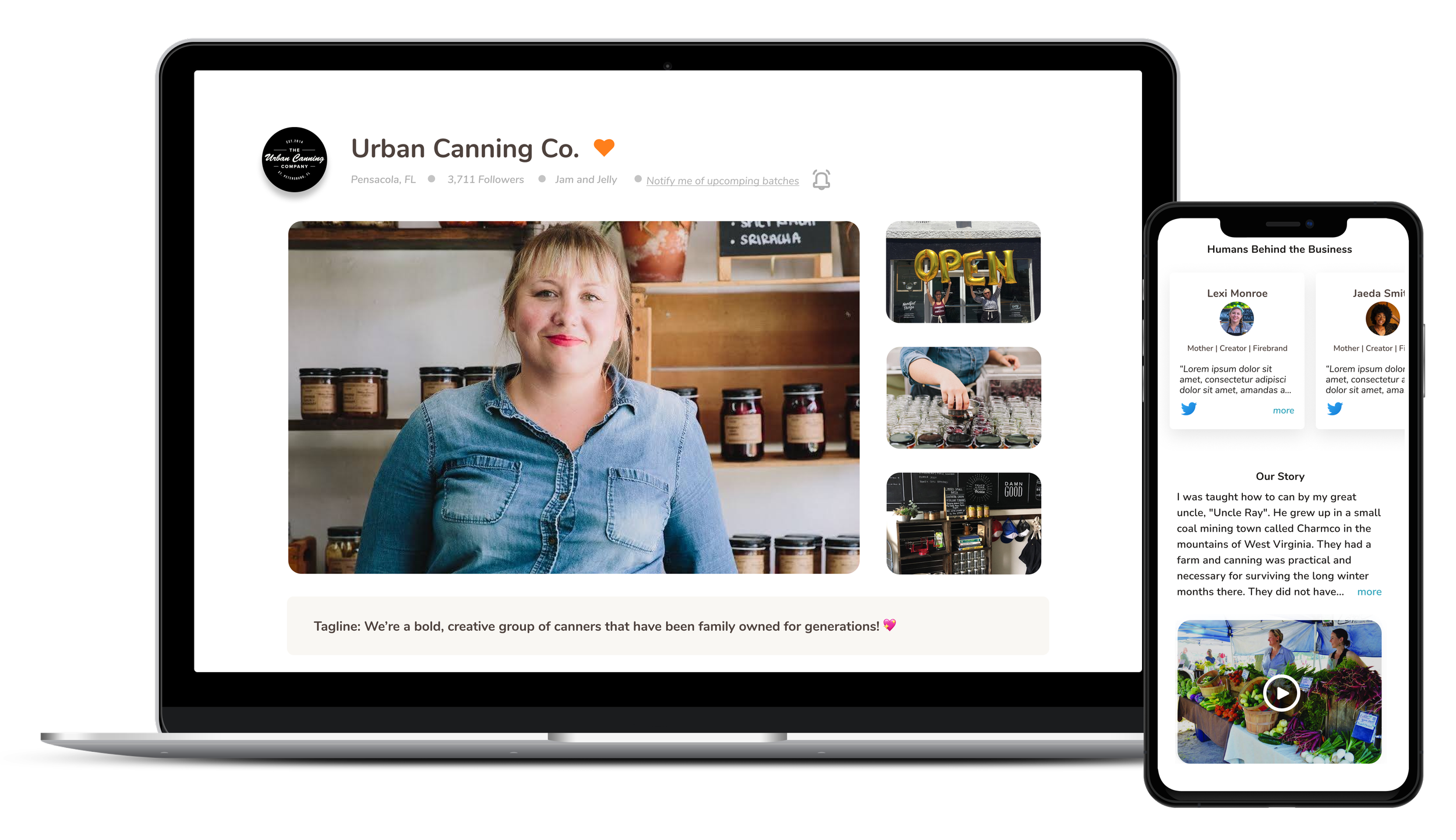
Designing Business Profiles That Connect Customers and Brands
Timeline:
3 weeks
Deliverables:
An editable business template profile page & solutions based in user research
Collaborators:
Product manager, CEO & founder of Barnraiser, offshore development team
How I Made it Happen:
Confirmed and expanded user research 🔎 | Defined key personas 👥 | Ideated user centered solutions 💡| Aligned stakeholders with prioritization exercise 🤝

Project Overview
Barnraiser is a community-driven marketplace for handcrafted, small-batch, and artisanal goods. Originally a successful crowdfunding site for local farmers, it is expanding into an eCommerce space. I contributed by designing a variety of features that support both merchants and customers.
In this project, I led research and design for the business profile pages, uncovering merchant needs, defining personas, prioritizing shared requirements, and creating flexible solutions that balanced merchant storytelling with customer engagement..
Process:
Stakeholder Interviews 2. Validating Assumptions With Research 3. Ideation & Prioritization 4. Solutions
Exploring the Problem
Stakeholder Interviews
During initial stakeholder interviews, Barnraiser’s CEO provided anecdotal evidence on their user base. These were a great starting point and warranted more exploratory research to validate and gain a deeper understanding to build the right solution.
From a product strategy perspective, Barnraiser revealed they aim to leverage the connections that merchants with their customers through their story. These customers weren’t just purchasing products — they were buying into the stories, values, and people behind them.
Barnraiser had difficulty implementing a structured way for their merchants to tell their story on their crowdfunding website. This led to inconsistent presentations: some merchants wrote lengthy, unfocused narratives, while others offered only a sentence or two. The lack of structure could made it difficult for customers to understand who these businesses were, resulting in less overall customer spend.
Independent Research
To validate stakeholder assumptions and uncover merchant needs, I got to work finding interview participants. I conducted five in-depth interviews with small-batch merchants and synthesized findings through affinity mapping.
The research revealed a unified set of goals—selling products and growing their brand and following—but exposed wide differences in technical capability. This gap highlighted the need for a platform that could support both tech-savvy merchants and those less comfortable with digital tools, ensuring everyone could effectively represent their business and connect with customers.
Summarized Findings
Merchants had compelling stories but needed structured, flexible ways to share them.
Customers needed both short-form and long-form content for browsing.
Part of the Barnraiser strategy was to leverage the connections and storytelling within the community.
Selling products was a universal priority, with all merchants seeking a clear, easy way to showcase and sell their offerings.
Merchants varied in technical capability, from highly digital to those needing more guidance and simpler tools.
Every merchant aimed to grow their brand, connect with customers, and expand their following.
Who Our Merchants Are
Based on five merchant interviews and stakeholder insights, two distinct personas emerged. The main difference lies in age and technical capability—some merchants are highly comfortable with digital tools and are knowledgeable on growing their brand, while others need simple, easy-to-use solutions. Despite this, all share aligned goals: growing their brand, connecting with customers, and sharing their story in ways that resonate with the community.

Problem Statement
Merchants have compelling stories but need structured, easy to follow ways to share them, while customers want the ability to browse both short-form and long-form content. Merchants vary in technical capability, yet all aim to sell products, grow their brand, and connect with customers. The challenge is designing a platform that supports these goals while accommodating differences in skill and enabling meaningful engagement.
Prioritizing Design Requirements
With two merchant personas and the customer base in mind, the design needed to balance multiple stakeholders’ needs. Using affinity mapping of research insights, I identified shared needs that were most critical to both merchants and customers.
These shared needs informed the highest-priority design decisions, while secondary focus was given to shared wants and individual needs—features that could benefit multiple stakeholders without detracting from core goals. Organizing priorities visually with a 2x2 matrix helped clarify tradeoffs and ensure design decisions supported flexible storytelling, product sales, and brand growth across varying levels of technical capability.
Solutions
MERCHANTS TELL THEIR STORY… LONG & SHORT
To help merchants share their story effectively, the design provides a structured framework that prevents overly long or too-short content. Customers can quickly scan key sections to understand the merchant, while still having access to full stories that convey the merchant’s personality and values—a critical part of the buying experience.
Tagline
A short, punchy statement at the top of the page to capture attention.
Mission
A deeper look at what drives their products and values, such as sustainability, craftsmanship or community impact.
Story
The merchant’s origin story, providing context and personality.
A Few Last Words
A friendly sign-off that adds a personal touch.
These editable sections had minimum and maximum character requirements and examples for merchants to follow.
Community Connections
Merchants need to grow their brand and reach new customers, which is a critical part of their business. At the same time, customers want to connect with merchants personally and understand the people behind the products. To address this, the design allows merchants to share updates, link social accounts, and highlight recent activity, giving customers insight into their personality and values.
This approach supports brand growth while fostering meaningful connections, encouraging engagement and repeat visits.
Interactive Q&A
Customers & merchants both love the connection they make and need a positive environment to do that. To solve this, the platform includes a moderated Q&A feature where customers can post questions and merchants can respond publicly or privately. This ensures meaningful engagement, giving customers the information they need while allowing merchants to manage interactions efficiently and in a positive manor, supporting both connection and brand growth.
Supporting Growth
Merchants need to grow their brand and customer base while showcasing their products effectively. To support this, the platform allows customers to favorite merchants and products and receive notifications when new items are available, helping merchants increase engagement, encourage repeat purchases, and expand their following without adding extra work on their part.
Wrap Up & Next Steps
Through research, stakeholder alignment, and iterative design, I delivered an editable business template that supports merchant growth and technical flexibility while giving customers clear, scannable ways to engage with merchants. I really enjoyed working on this project and seeing how thoughtful design can empower both merchants and customers. Next steps include testing with live merchants and gathering customer feedback to further refine the experience.







